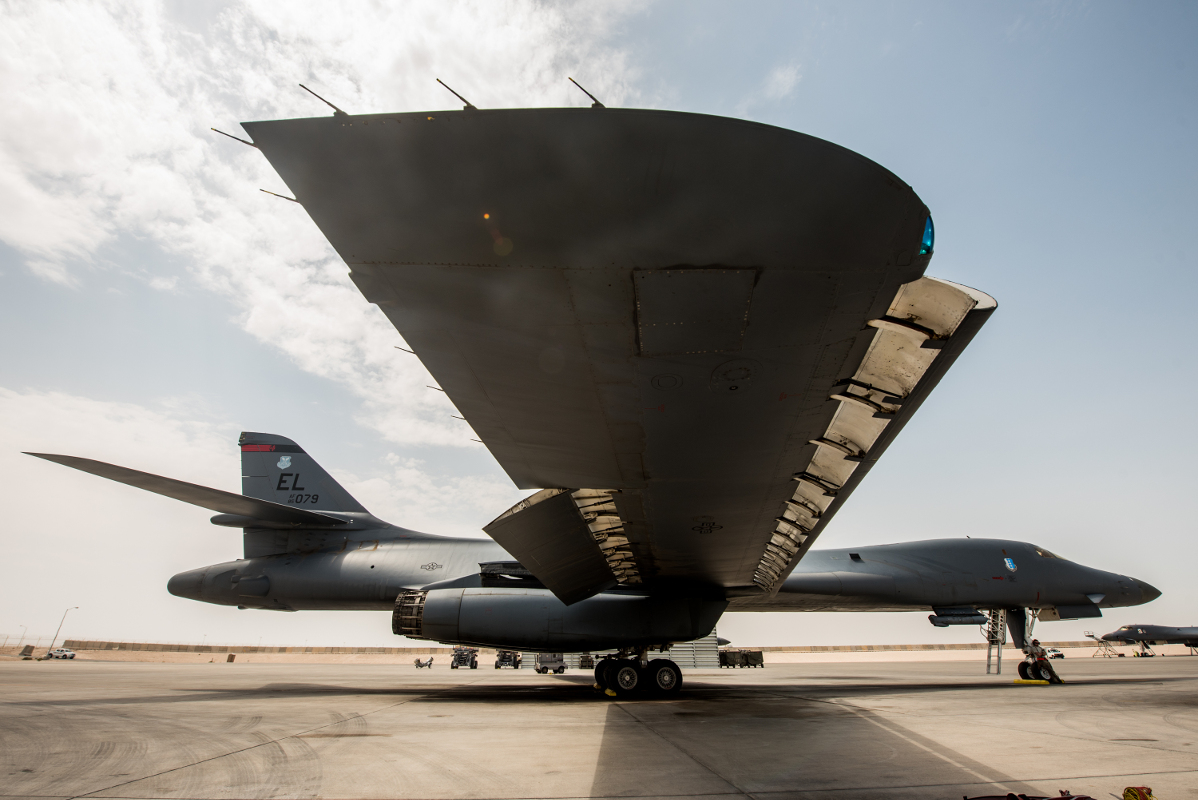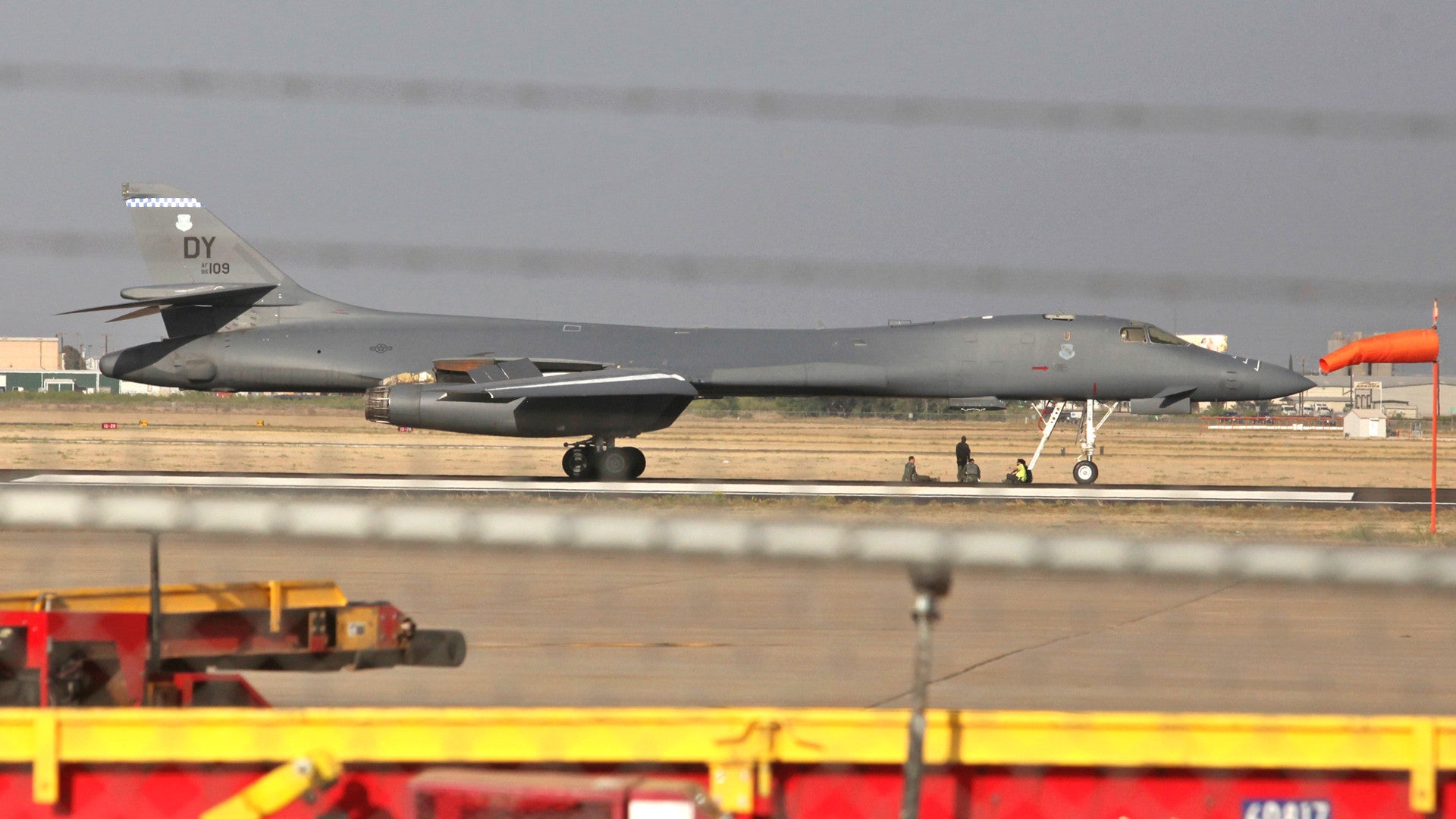The U.S. Air Force has grounded its entire fleet of B-1B Bone bombers due to unspecified concerns about the aircraft’s ejection seats and has no fixed timeline for when it will clear the planes to fly again. The decision comes as an investigation continues into an emergency landing involving the type in May 2018 and amid growing concerns about the readiness of the U.S. military aviation communities as a whole.
U.S. Air Force General Robin Rand, head of Air Force Global Strike Command, which oversees all of the service’s combat-coded bombers, ordered the so-called “stand-down” on June 7, 2018. On May 1, 2018, a B-1B bomber assigned to the 7th Bomb Wing at Dyess Air Force Base made an emergency landing at Midland International Air and Space Port in Midland, Texas after declaring an in-flight emergency. The incident involved a fire in one of the aircraft’s engines and resulted in an emergency exit hatch coming off in mid-air.
“During the safety investigation process following an emergency landing of a B-1B in Midland, Texas, an issue with ejection seat components was discovered that necessitated the stand-down,” Air Force Global Strike Command, which oversees all over the service’s combat-coded bombers, said in a brief statement on June 8, 2018. “As issues are resolved aircraft will return to flight.”
As of May 18, the service continued to decline to say whether it had recovered the hatch or if there had been any actual malfunction in one or more of the plane’s ejection seats, according to a report from Defense News. The bomber had a standard crew of four on board during the mishap, none of whom suffered any injuries. The swing-wing bomber was not carrying any weapons, the Air Force told the Midland Reporter-Telegram at the time of the accident.
Unconfirmed posts on the unofficial Amn/Nco/Snco Facebook Group said that the aircraft’s Offensive Weapon Systems officer tried to eject, which caused the hatch to come off, but that their Advanced Concept Ejection Seat (ACES) II ejection seat failed. Additional notes indicated that the decision to make the emergency landing at Midland came after that individual became stuck and it remains unclear if the aircraft’s pilot had ordered any of the crew to eject.
The United Technologies Corporation (UTC) seat is also found on the Air Force’s A-10 Warthog, B-2 Spirit, F-15C/D Eagle, F-15E Strike Eagle, F-16 Viper, and F-22 Raptor aircraft. There is no indication yet about whether or not the issue on the B-1s extends to the seats on any of those aircraft.

The Air Force itself has been especially tight-lipped about the incident. Before announcing the stand-down, the last official statement had come from Dyess Air Force base on May 21, 2018. That “update” only restated information that service had already released and reiterated that the official investigation was still ongoing.
But the grounding could have a significant, immediate impact on U.S. military combat operations and other activities. In April 2018, some of the Air Force’s more than 60 B-1Bs touched down at Al Udeid Air Base in Qatar to take over for B-52 bombers that had been flying missions from that base. From there, the Bones have been supporting operations against ISIS in Iraq and Syria and the continuing campaign against the Taliban and other insurgents in Afghanistan.

The B-52s had themselves taken over for the B-1Bs in 2016 when the Bones returned to the United States to receive the Integrated Battle Station upgrade. This package included updated avionics and data links, as well as a self-diagnostic test system.
The Bones also regularly take part in drills and other security cooperation activities around the world, as well, including recently deploying to the United Kingdom to take part in the annual Baltic Operations (BALTOPS) exercise. This event includes air and sea training missions in and around the immensely strategic Baltic Sea. The B-1Bs, as they typically do during this drill, trained to employ air-dropped Mk 62 Quickstrike naval mines, which could be essential in limiting a hostile navy’s ability to move freely in the area during a crisis.

But the in-flight emergency over Texas and the subsequent grounding has come as the U.S. Air Force, as well as the rest of the services, continue to struggle with a serious spike in aviation mishaps. So far, in 2018 alone, accidents have killed more than two dozen U.S. military aviators.
There has been a slew of in-flight emergencies across the Air Force for various different reasons since the incident in Texas, but thankfully without any injuries. Many more never get reported publicly.
There has been a surge in crashes, too. On May 23, 2018, a T-38C Talon jet trainer also crashed in Mississippi, but the crew was able to safely eject. This was the first Air Force crash after a WC-130H from the Puerto Rico Air National Guard came down in Georgia on May 2, killing all nine individuals on board.
The Air Force says it is taking steps to investigate whether there are systemic problems at play across the service and it completed a service-wide safety review on June 6, 2018. According to Military.com, the Air Force said at least some airmen used anonymous “safety channels” to submit information, which individuals typically do out of fear of retaliation from their superiors.

“Air Force active-duty units have completed the Operational Safety Review announced in May, while Reserve and Guard units still have until June 25 to complete the review,” Erika Yepsen, an Air Force spokesperson, told Military.com. “The feedback will be reviewed across Air Force organizational levels – wings, major commands, as well as Headquarters Air Force.”
There was no clear indication of what the review had concluded and what recommendations it might have for units across the Air Force. The Pentagon and the individual services have all repeatedly insisted that the surge in mishaps is not a broad crisis and that each individual incident is a unique confluence of factors.
However, there is significant evidence to show that the Air Force and other services responded to years of budget cuts and caps by pulling funding from operations and maintenance accounts, which has had a cascading impact on readiness throughout the U.S. military. In addition, the Air Force, in particular, has been experiencing an unprecedented shortage of pilots and maintenance personnel, which can only have exacerbated the issues.
“The safety of Airmen is the command’s top priority,” Air Force Global Strike Command said in its June 8, 2018 statement. “The Air Force takes safety incidents seriously and works diligently to identify and correct potential causes.”
Hopefully the issues with the B-1Bs ejection seats, and any other problems the investigation into the May 1 mishap turn up, will be easy to fix and those Bone crews can get back flying safely soon.
Contact the author: jtrevithickpr@gmail.com
